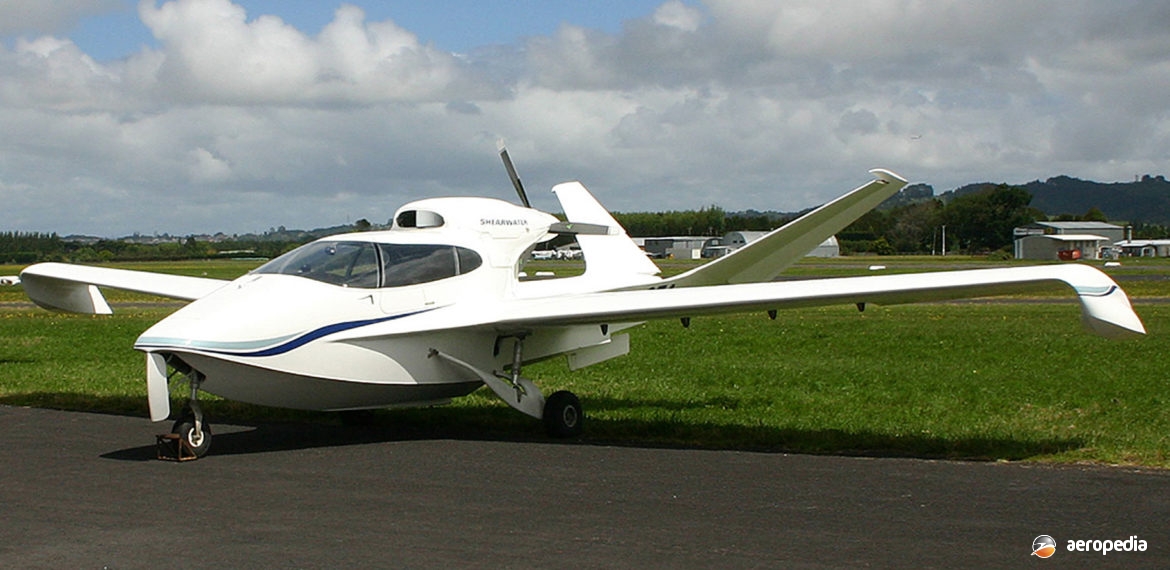Photograph:
Seaflight Shearwater ZK-SFA (c/n 1) at Ardmore, New Zealand in 2005 (Shearwater Industries)
Country of origin:
New Zealand
Description:
Four-seat light sport amphibian
Power Plant:
One 157 kw (210 hp) Franklin PZL-L four-cylinder horizontally-opposed air-cooled engine
Specifications:
- Wingspan: 11 m (36 ft 1 in)
- Length: 8.56 m (28 ft 1 in)
- Height: 2.65 m (8 ft 7 in)
- Wing area: 17.18 m² (185 sq ft)
- Max speed: 266 km/h (165 mph)
- Max cruising speed: 249 km/h (155 mph)
- Stalling speed clean: 107 km/h (67 mph)
- Stalling speed, flaps down: 92 km/h (57 mph)
- Range: 1,297 km (806 miles)
- Empty weight: 850 kg (1,874 lb)
- Loaded weight: 1,400 kg (3,086 lb)
History:
The Shearwater was a four-seat amphibian designed by Mr W Townson and built by his company, Seaflight (NZ) Ltd, over a period of seven years, the prototype (initially ZK-SFA – c/n 1) making its first taxiing trials on Mahurangi Waters in early 2001, and making its first flight later that year on 28 September. The design was developed by the use of a series of one-fifth scale models. The prototype became ZK-SFA on 12 November 2001, being powered by a 157 kw (210 hp) Franklin four-cylinder engine, this being a Polish-built O-350-PZL-6 variant of the American Franklin engine, driving an Ivoprop three-blade variable pitch propeller. The registration later on 5 May 2005 was changed to ZK-TNZ. Later the registration was changed back to ZK-SFA, the address of the owner at that stage being Seaflight (NZ) Ltd of Warkworth.
Designed from its concept to operate from a saltwater environment, the aircraft was built from composite materials and stainless steel. Scale models were built and tested to prove parts of the design, these being towed behind a boat in order to refine the fuselage shape. Design and stress calculations were carried out in the United States. Modelling was said to have taken three years, and construction of the prototype took another four years.
The design was unusual in that the pusher propeller was mounted low on the fuselage with the propeller recessed into the VEE part of the fuselage to give clearance. The wings had some taper and were turned downwards at the outer extremities, acting as wing-tip floats.
The cabin was 147 cm (54 in) wide and was roomy, providing comfortable accommodation for four. It had a tricycle undercarriage. The fuselage was built in a V-shape behind the engine leading to a V-tail. Vent holes were built into the double step in the bottom of the fuselage, and these were fed with air through the wheel bays to assist breaking suction, thus permitting the aircraft to plane better on the water. The wings were removable for road transportation. Fuel capacity was 518 litres (114 Imp gals). After certification testing, Mr Townson and his business partners indicated they intended to develop the design and release it as a kit aircraft on the world light-aircraft market.
In July 2005 the prototype was taken to and displayed at AirVenture, the United States Experimental Aircraft Association meeting at Oshkosh in Wisconsin where it was placed on display, at this time having completed 30 hours. It is believed there was some interest in the design and orders were said to have been received. Production aircraft were expected to have a 190 kw (255 hp) Innodyn 255 TG turboprop driving a five-blade propeller or normal combustion engines in the 157 kw to 186 kw (210 to 250 hp) range could be installed. At one stage it was announced four kits had been sold in New Zealand. The company later became known as Shearwater Aircraft of Christchurch, ownership changing to this Company on 4 November 2004. It was announced this Company planned to market the kit aircraft commercially.
However, Shearwater Aircraft decided to abandon the design in late 2005 and begin designing a new aircraft under the direction of aeronautical engineer, Richard Roake. The aim at this time was to reduce drag and improve performance, with the first aircraft of the new design to be completed by 2007. It was also decided to change the power plant from the Innodyn turbine to a Mistral G300 unit. This engine was a variant of the Wankel rotary engine developed by Mistral Engine Co and had three rotating combustion chambers, used a liquid cooling system, had a digital management system, and produced 224 kw (300 hp) in standard form. With optional turbocharging this increased to 269 kw (360 hp).
The new aircraft then became known as the Shearwater 301, but was renamed in 2011 the Shearwater 201. A 25% scale model was built to test the format in 2007. By this time the design had received a number of changes, including a retractable ski for water landings.
Initial components for kits were to be made available in 2008 but are not believed to have been delivered. The ownership of the prototype was returned to Seaflight (NZ) Ltd on 5 November 2007 and on 13 October 2009 it again became ZK-SFA². In July 2011 at the EAA event at Oshkosh the design was again displayed and it was announced a new prototype would be built. However, no new aircraft had been completed by mid-2016. The prototype in 2016 remained on the NZ Civil Aircraft Register but has been inactive. At one stage it was mooted the owner, Martin Farrand, intended in the future to install a Lycoming IO-540 engine. In mid 2021 the aircraft was fitted with a 224 kw (300 hp) Continental engine.

